German Spaetzle: Gorgeous Rustic Eggy Homemade Noodles
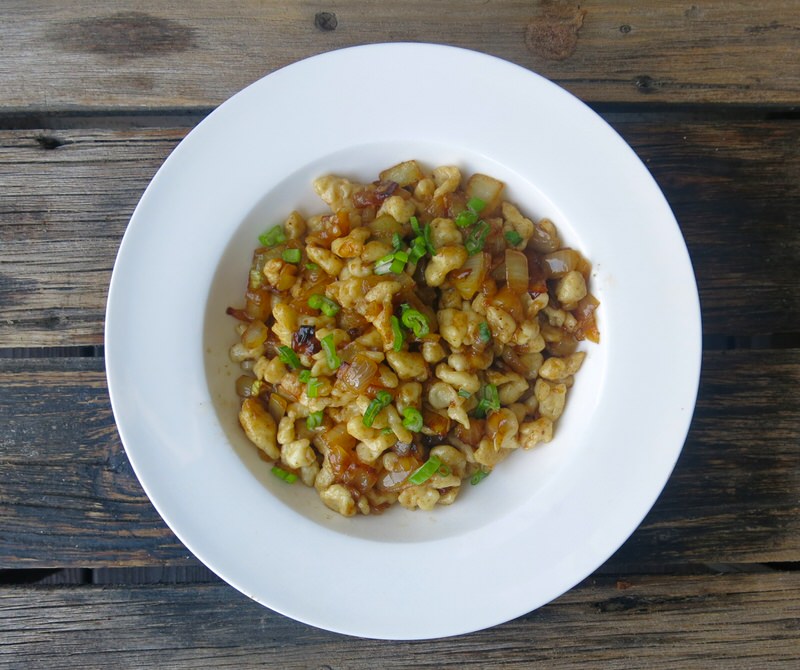
German Spaetzle or Spätzle reinvented for Vanja’s breakfast the morning after our lovely Sunday Supper of German Fleisch Rouladen. Making German Spaetzle or Spätzle was part of the Valerie Cooking in the Kitchen with Margaret Bose Johnson day. She taught me how to make the most tasty, chewy, eggy, scrumptious German noodles which I will share with you.
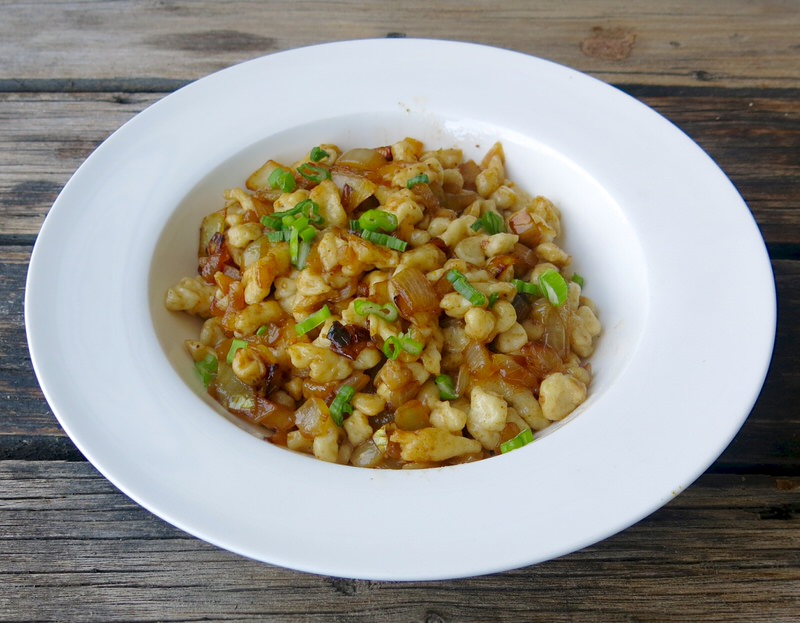
Sunday Brunch for Vanja is often his favourite platter of bacon and eggs. This morning, the browned butter and caramelized onion were tossed with the Spaetzle and a little fresh green onion, and oh, my. This was another plate lickin’ lip-smackin’ wonder.
German Spaetzle or Spätzle (egg noodle): A Little Background Information
First, there are a host of tools created to make the little sparrow shaped egg noodles. Margaret’s favourite from Germany was inaccessible due to renovations, so she demonstrated various techniques to me, including the old and traditional hand cut Spaetzle.
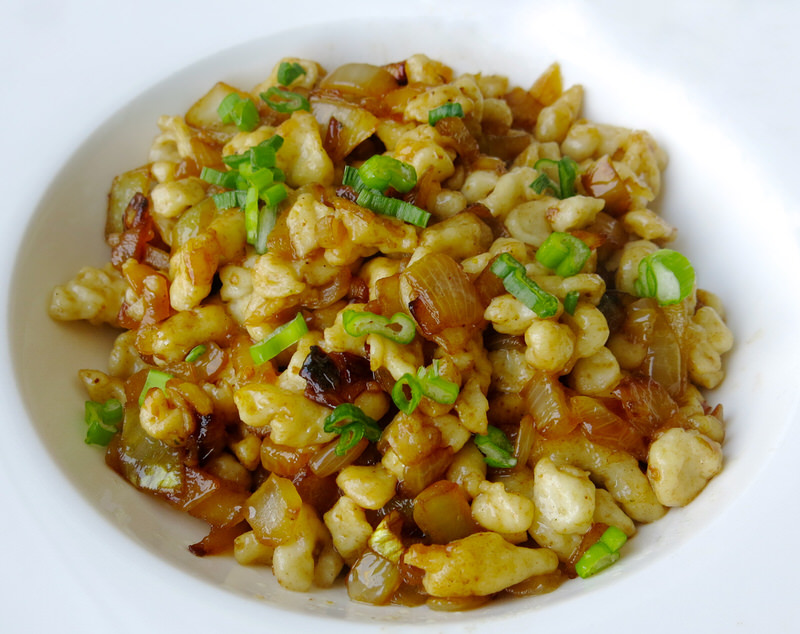
I was a little worried about making the entire recipe Margaret shared with a dozen eggs and 6 cups of flour, until she told me how fabulously it freezes: similarly to that of pyrogies or rice. Perfect. Big batch it is. She added that there are a myriad of other ways to serve it like tossing it with cheese. Hmmm. I later learned that is called Spätzle mit Käse überbacken where warm spätzle is simply mixed with cheese and topped with paprika.
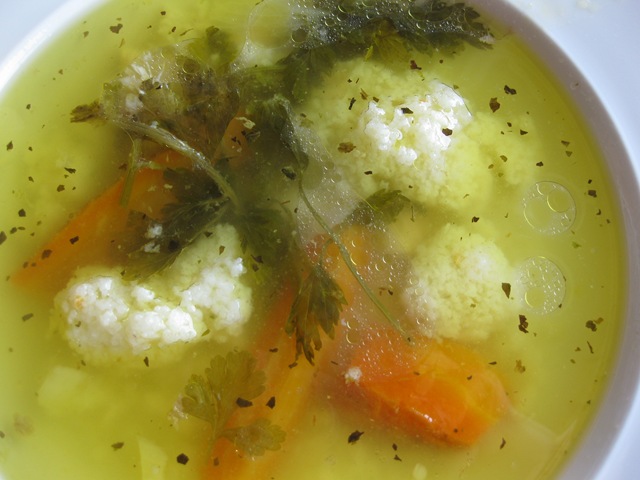
Investigating further, I could see Vanja’s mom likely knew how to make a Serbian or Eastern European version of Spaetzle as she also made knedle in special soups which is the same dough and sometimes with a little chicken liver mixed into it for soups. I think Pava just spooned her dough and dropped it into the soup by spoonfuls, similar to the handcut style, but with a spoon.
- Käsespätzle is another version of spätzle mixed with grated Emmenthaler cheese and fried onion. That would definitely stick to your ribs!
- Krautspätzle is spätzle mixed with sauerkraut, onion, butter and herbs or even caraway.
- There is even a version where pureed spinach is mixed into the dough.
- Kirschspätzle is a sweet version where the dense eggy noodles are mixed with fresh tart cherries, dressed with clarified, browned butter, sugar, cinnamon and nutmeg sometimes served as a one-dish supper in late summer during cherry season.
- Apfelspätzle is made with grating apples into the spätzle dough, also dressed with clarified, browned butter, sugar, and cinnamon and served as a one-dish supper in apple season, late autumn.
From Wikipedia: “…literally “little sparrows”, also Spätzli or Chnöpfli in Switzerland or Knöpfle or Hungarian Nokedli, Csipetke or Galuska; an egg noodle found in the cuisines of southern Germany and Austria, Switzerland, Hungary, Alsace, etc.”
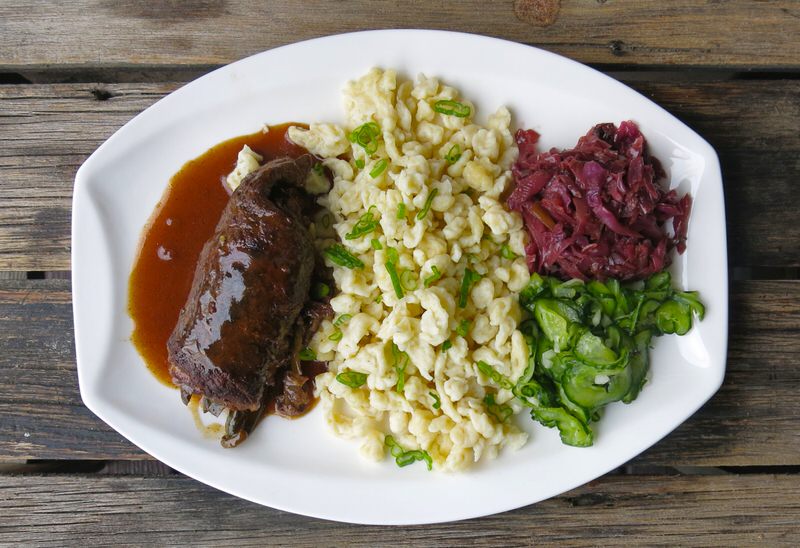
Served traditionally, as above, everyone agreed that the gravy breathed life into the Spaetzle and that the Spaetzle did the same for the gravy. I, personally, loved it plain, with butter and salt. This is not a light tender pasta like noodle. It is dense, toothsome and full of eggy flavour.
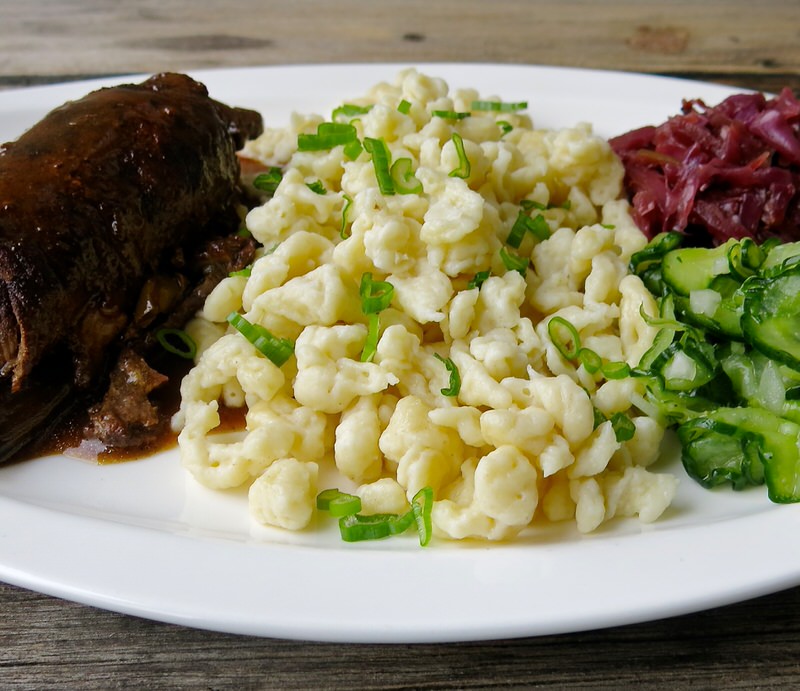
Margaret’s site is Kitchen Frau and not to be missed. She participated in Project 2017: Valerie Cooking in the Kitchen with… making this entire meal with me and has been a favourite read of mine for years. Be sure to stop by, say hi and how much you love her recipes here! Remember our project hashtag please: #ACFValerieCookingwithYOU!
German Spaetzle or Spätzle (soft egg noodle):Mis en Place – or not!
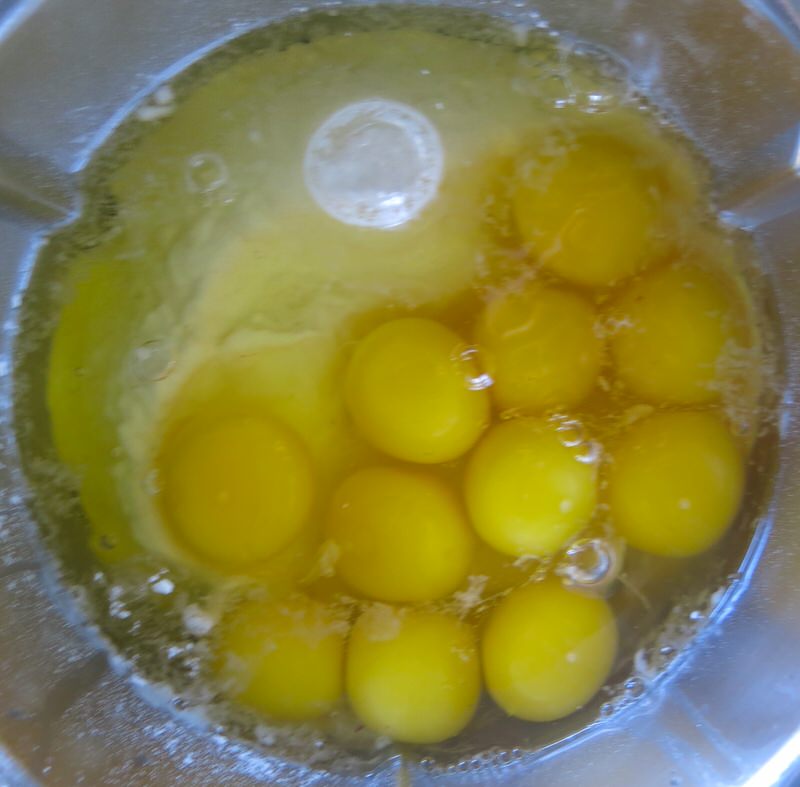
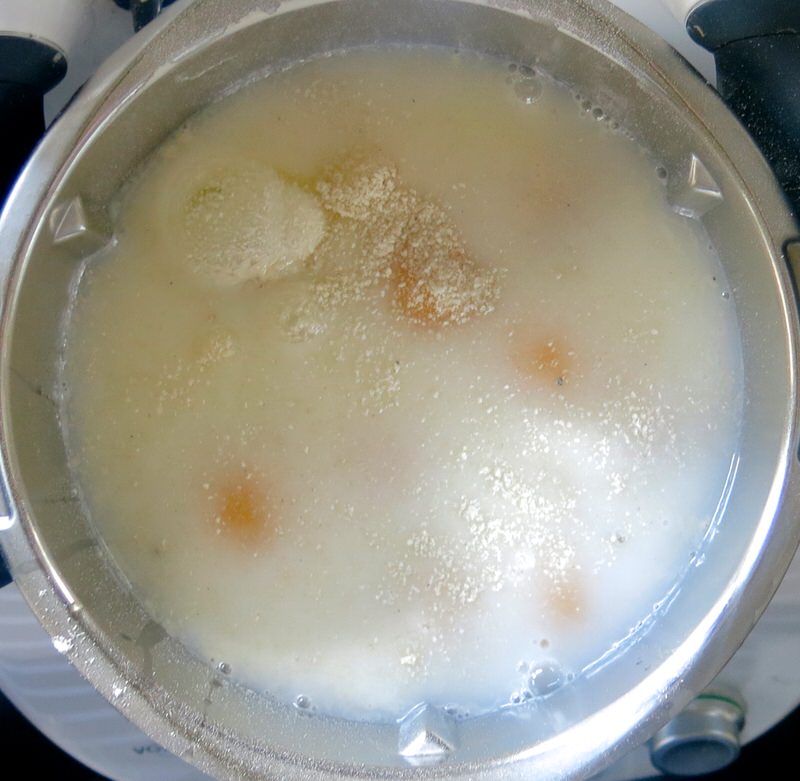
Of course I made it in my Thermomix. Instructions are in the recipe for both methods. The mis en place? Woops! Twelve eggs, 6 cups flour, 150 grams milk, 150 grams water, and salt. Simple. As mentioned above: ground spinach, chicken liver, herbs, paprika, even a portion of semolina and whatever the imagination can come up with can be added to the ingredients and mixed into this strong and independent German dough.
German Spaetzle or Spätzle (soft egg noodle): Making the Batter and achieving proper Spaetzle Dough Consistency
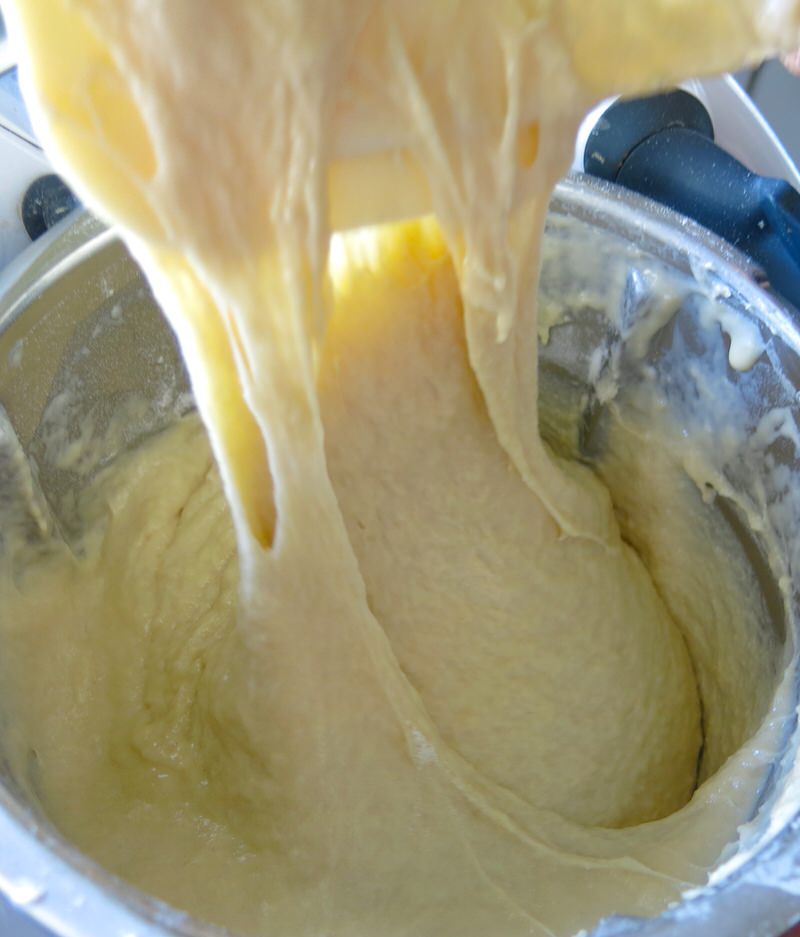
This is as much a dough as it is a batter. A batter is loose. A dough is tight. Yet, a batter is shiny and a dough is matte. This is a shiny dough. You have the correct consistency when the dough holds its own when plopped onto a work surface and oozes slowly like lava. It is elastic and will stay momentarily in a blob when placed on a small board or on the maker. The dough is viscous and will “run” or slump slowly. It is dough-like and batter-like when the correct consistency has been reached. It is shiny and “sheets” when pulled from the bowl with a spatula as in the above photo. You have to pinch it to separate the portions as it is so elastic and stretches so much. You will also see, below, during the making of the noodles, how the dough sits on the Spaetzle Maker. The dough can be made looser, and some do that, by adding more liquid. The noodle texture is then different, lighter and softer, some might say “fluffier” but this is often done due to personal preference, upbringing, or to accommodate the process due to the maker being used. Margaret’s mom only used eggs, flour and salt. They were raised with a chewy, toothsome eggy noodle. This is what she grew to love and has taught us here.
German Spaetzle or Spätzle (egg noodle): Making the Noodles
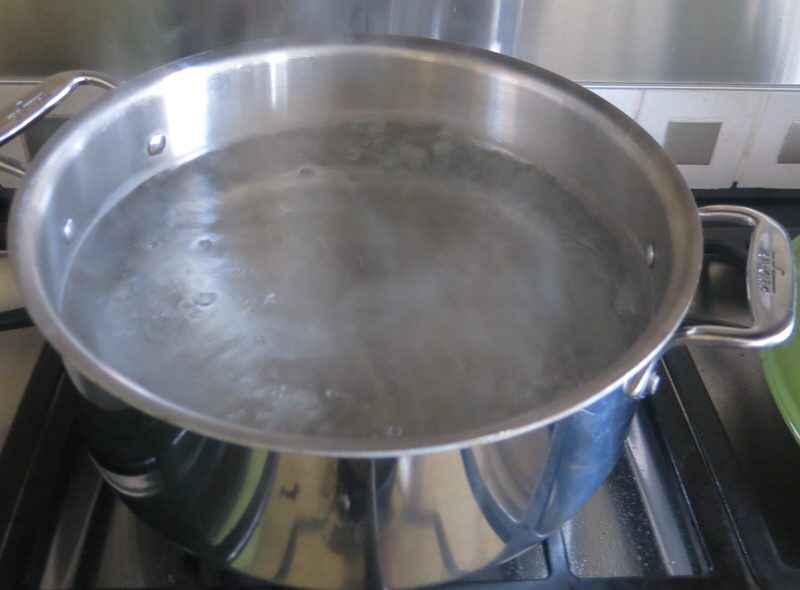
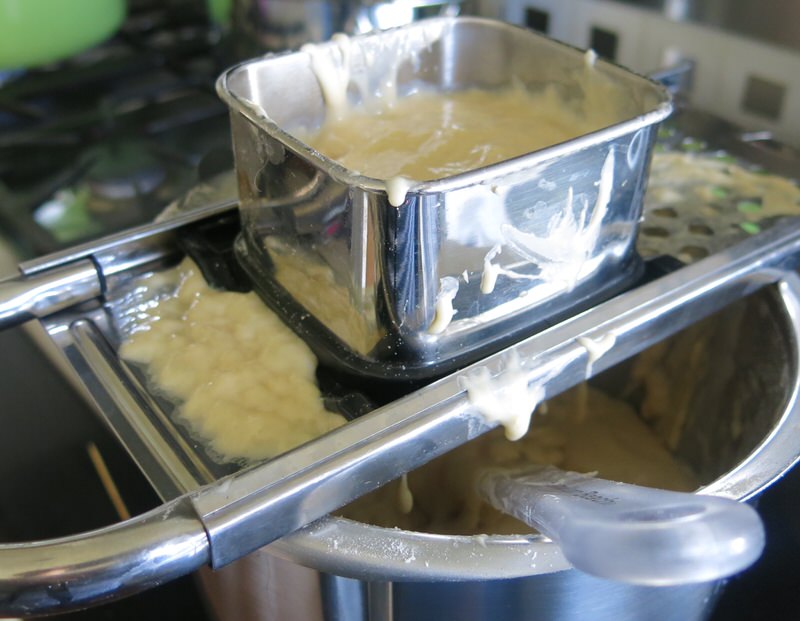
Yup. Now I remember why I only used this Spaetzle maker twice. It is a pain and creates a huge mess as the dough gets pushed over the end of the maker with the box on top and spills all over the stove top. The box doesn’t fit tightly enough, either, and batter escapes all over the place.
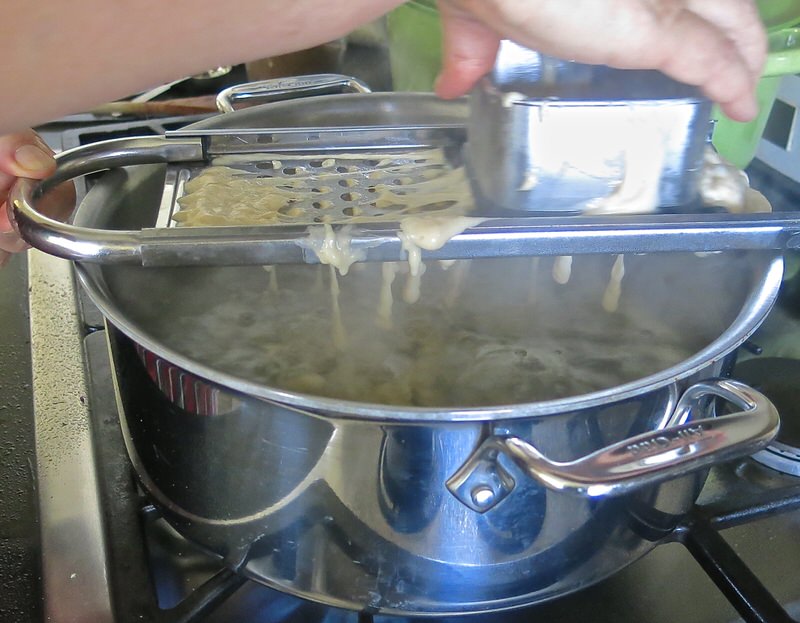
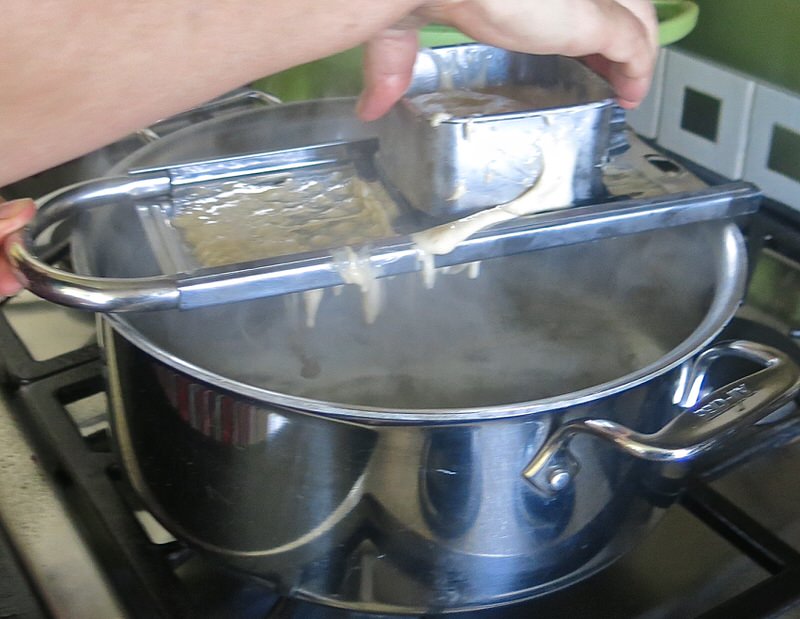
But, we tried. Then, Margaret said, “OK. That’s enough of that. Let’s do this. It should work better.”
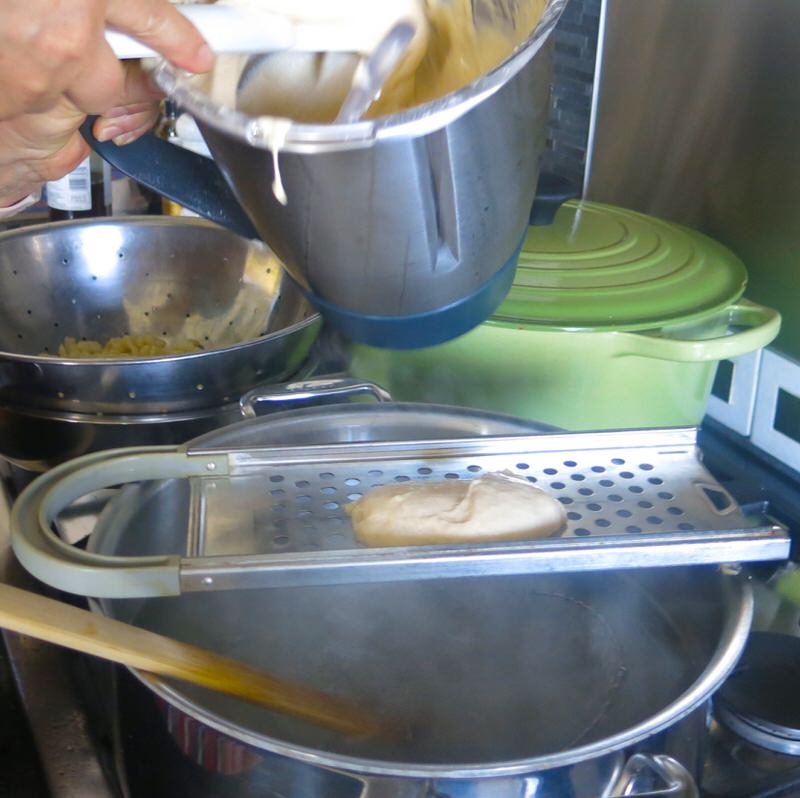
She plopped a dollop of the dough onto the middle of the maker, used a firm hard, unyielding spatula, and pushed the batter through the holes in the maker with a rigorous and rhythmic back and forth motion. It looked hard, til I tried it myself: easy, peasy! But, without her showing me, I would have never arrived at this solution. Above, the dough sits on the Spaetzle maker without slumping. The consistency is perfect when the dough behaves like this.
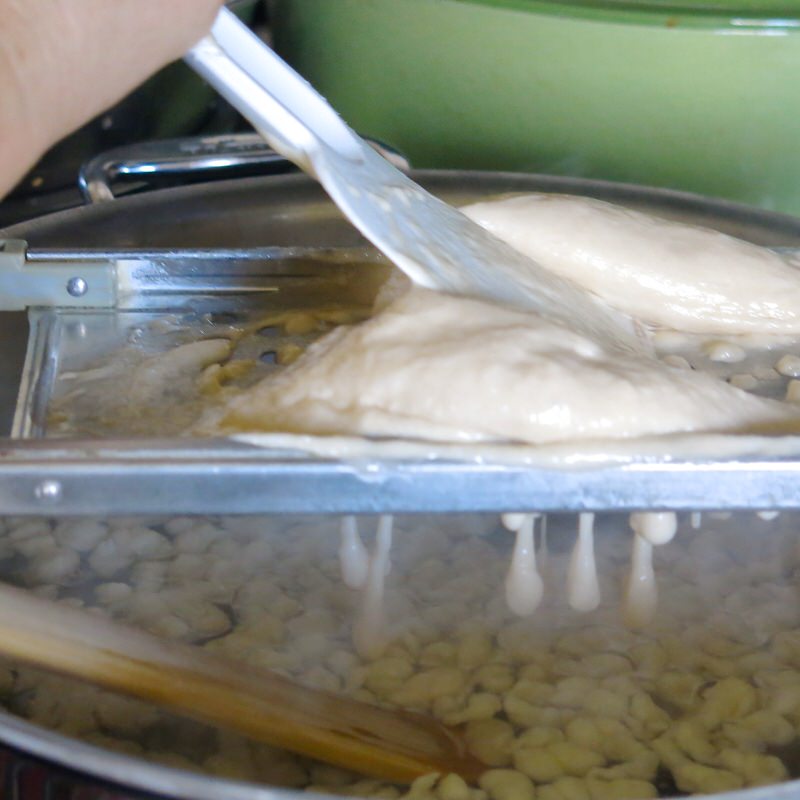
The little sparrows plop into the boiling water, below.
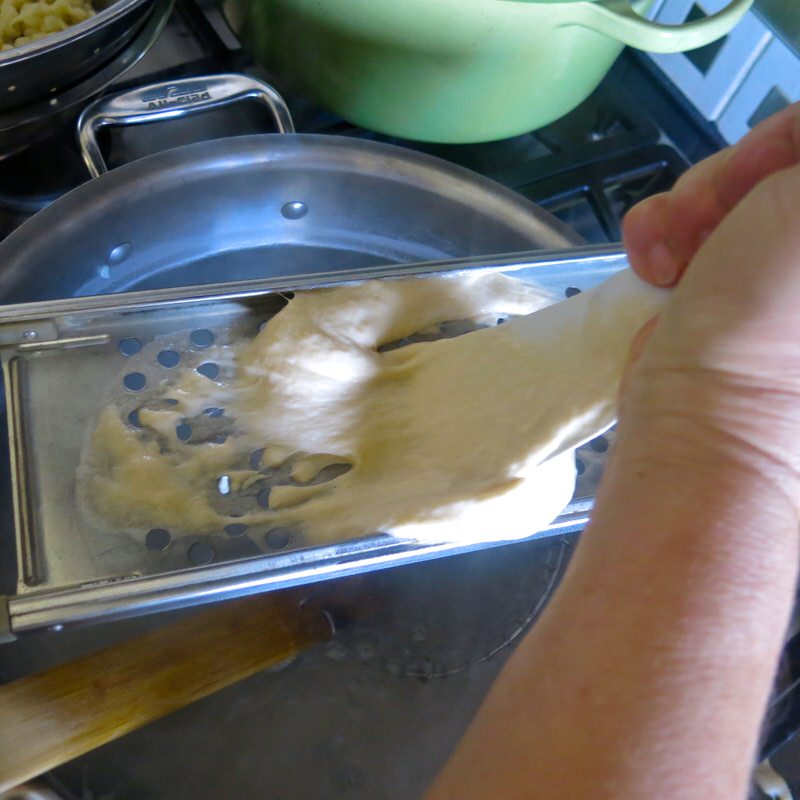
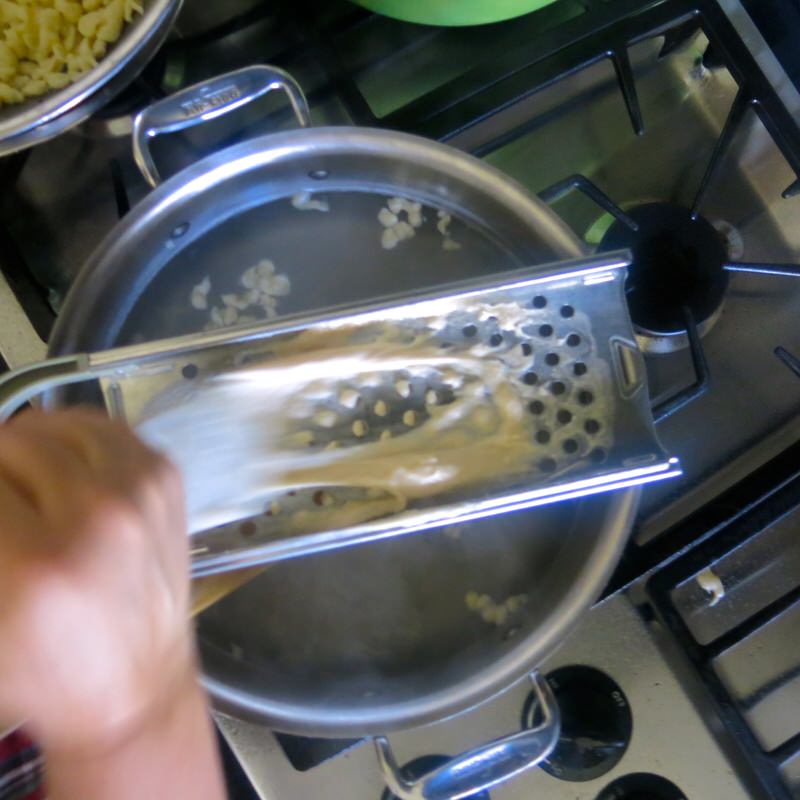
She pushed to guide the dough through the full width of the maker both directions.
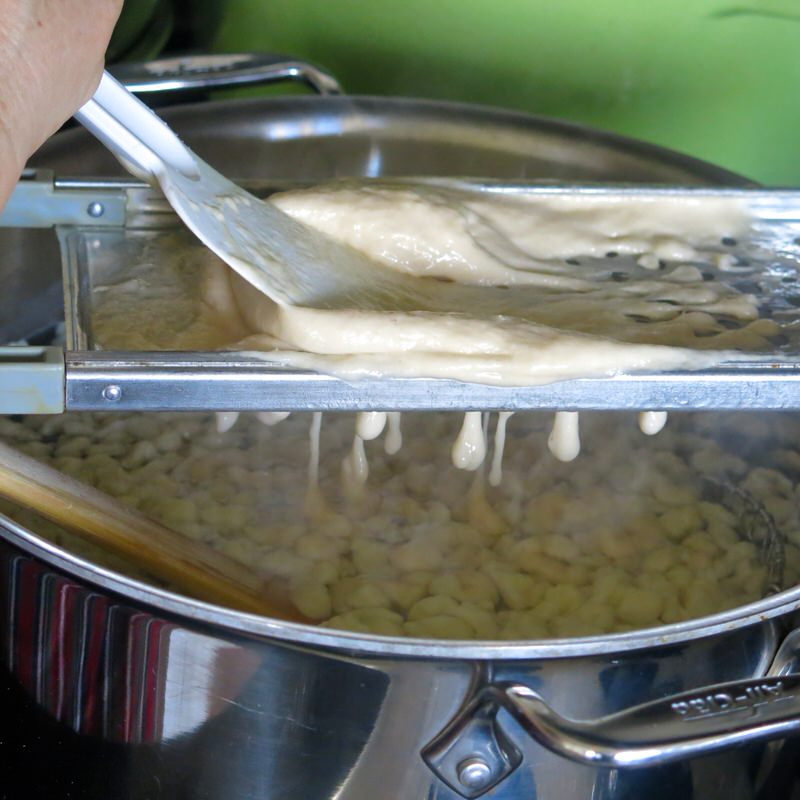
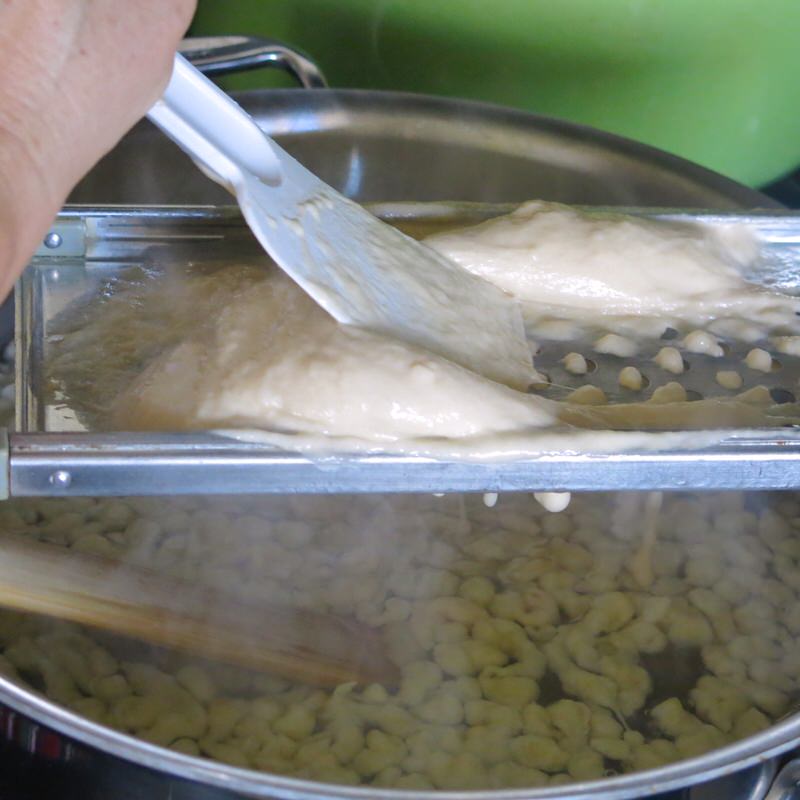
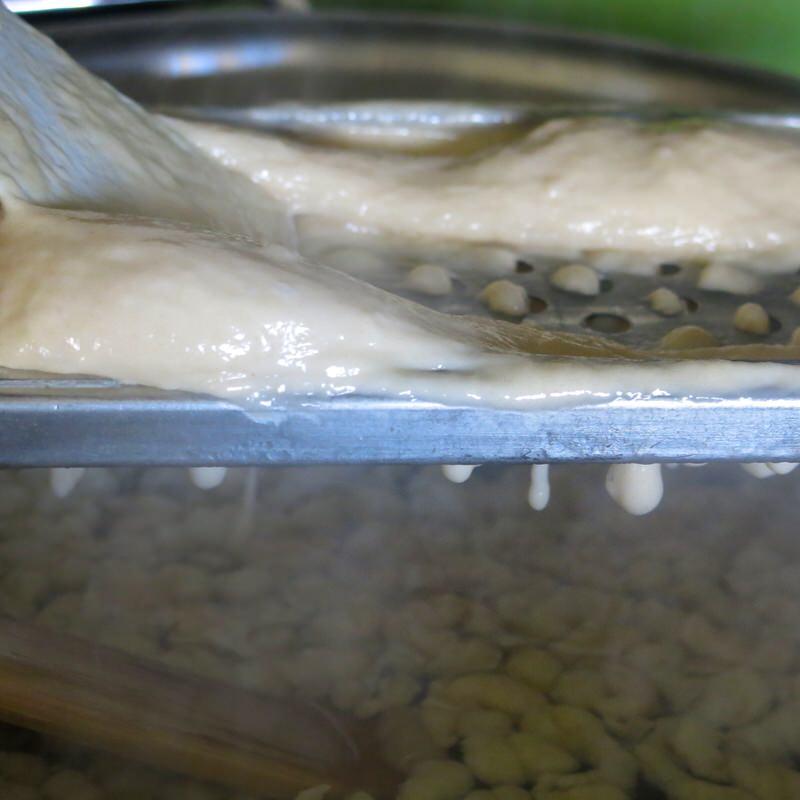
My turn! Look mom! I can do it, too! As Prince William would say: “I did it self!”
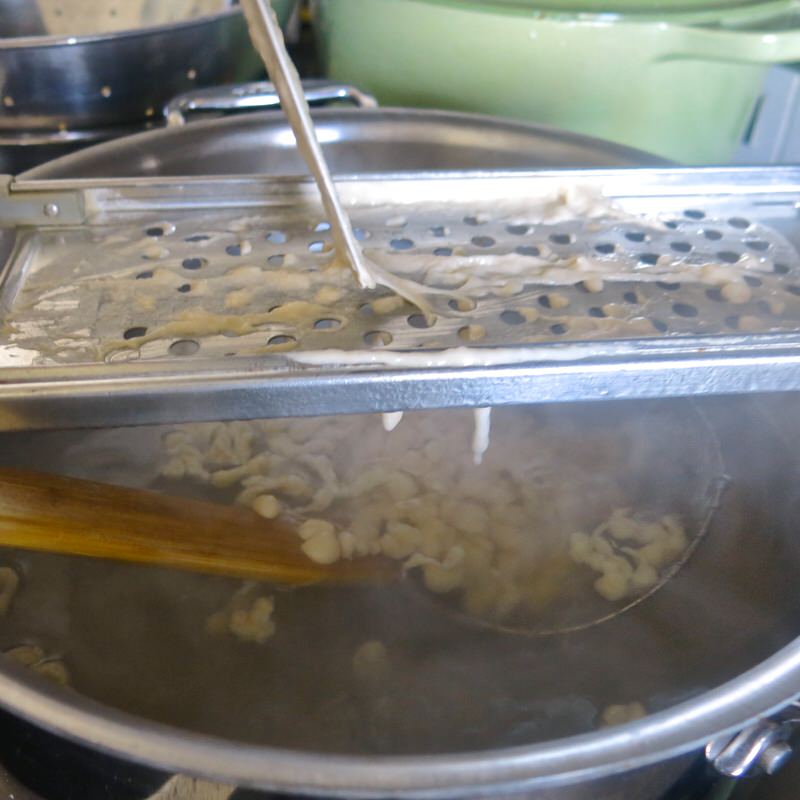
Once that amount was pushed through, we would do one more before straining the egg noodles from their water bath and buttering them in the colander.
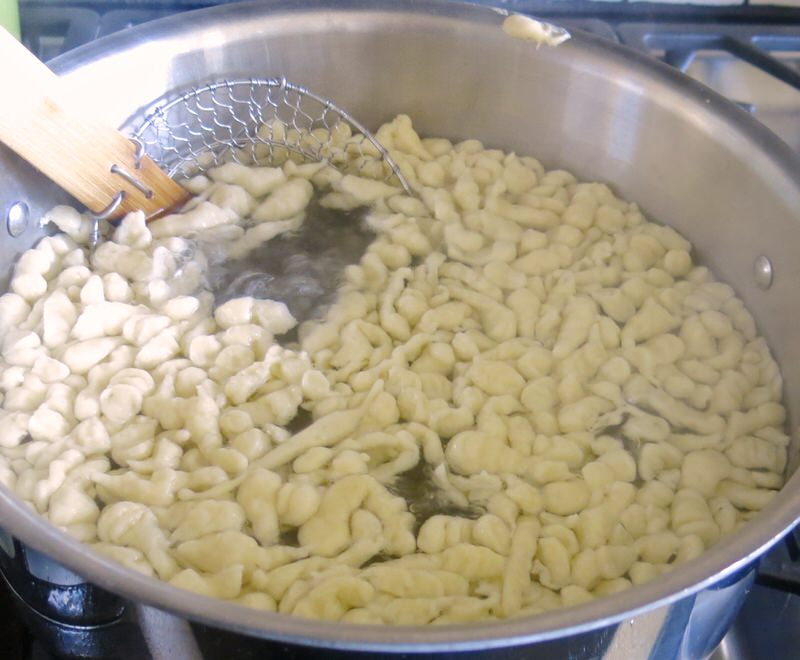
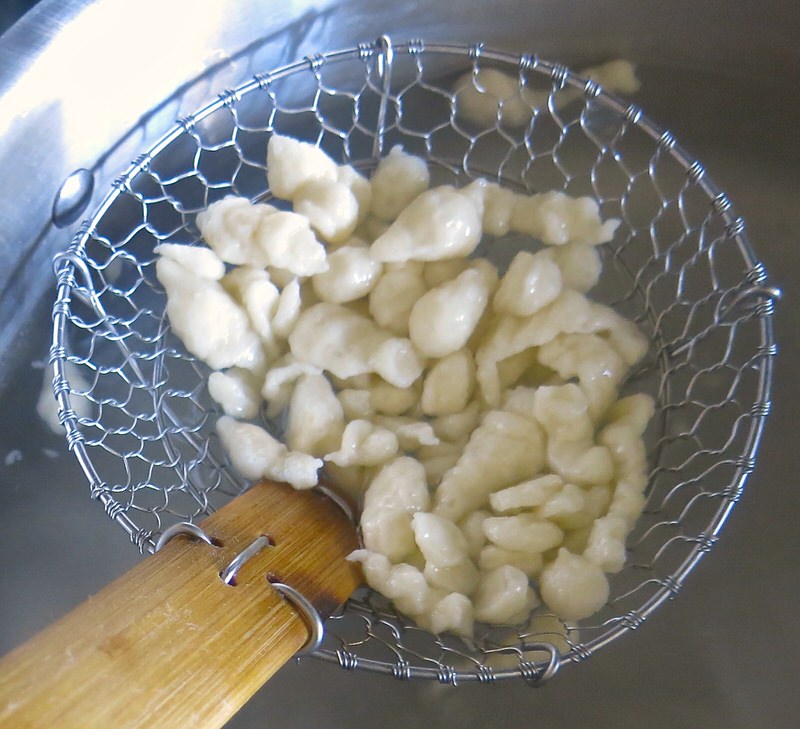
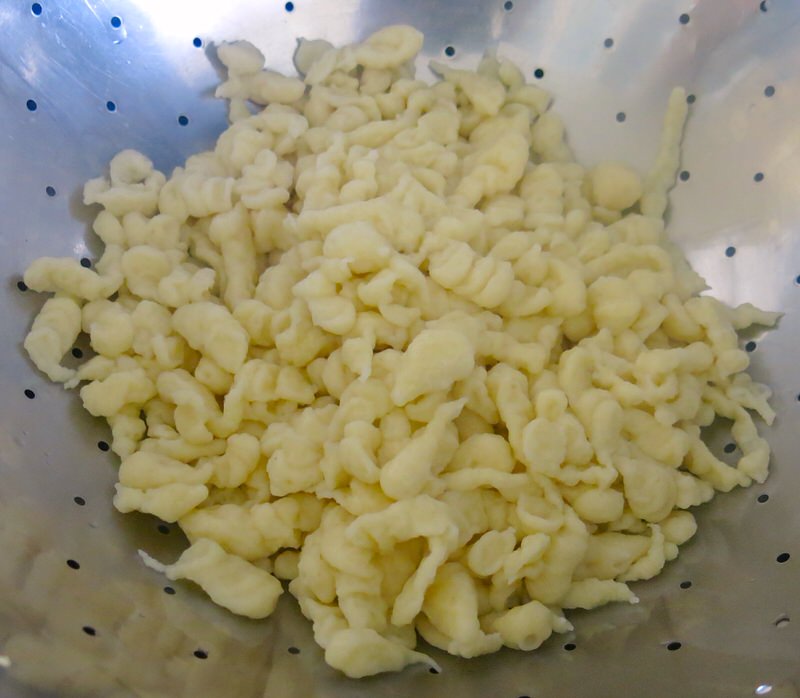
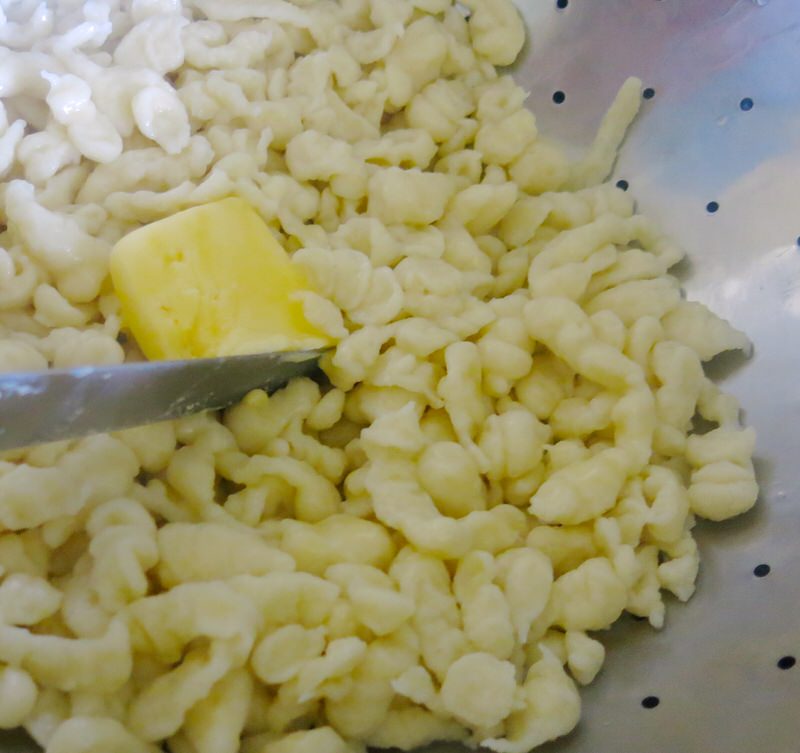
Let the water come back to a boil when finished with the dough. Ensure all have risen to the surface. Once the last bit has been cooking for at least 1 minute, remove to the colander and add a pat of butter to ensure they don’t clump. Let them drain, and continue with the next bit.
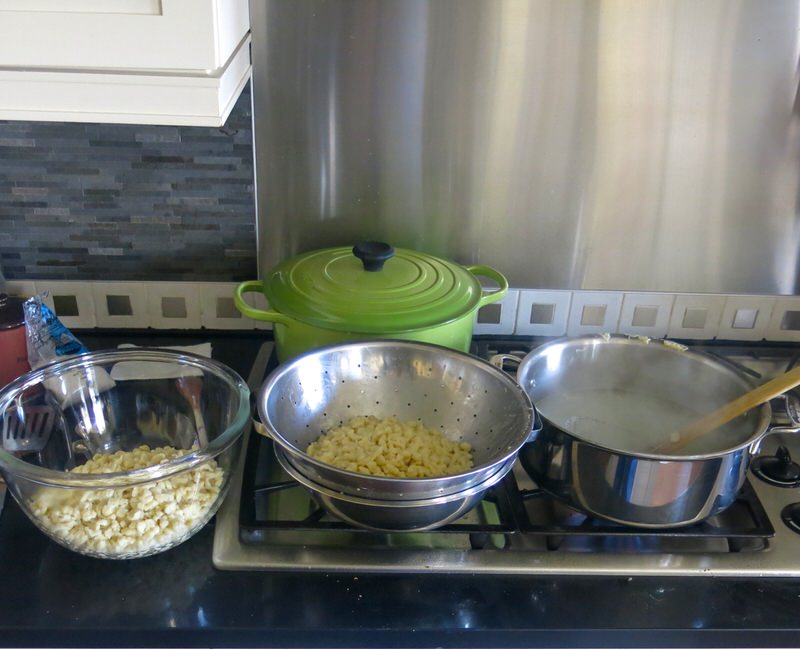
Once the next batch is complete, and you are letting the water bath come back to a boil for a minute, transfer the noodles from the colander into the bowl; continue to toss to avoid any clumping.
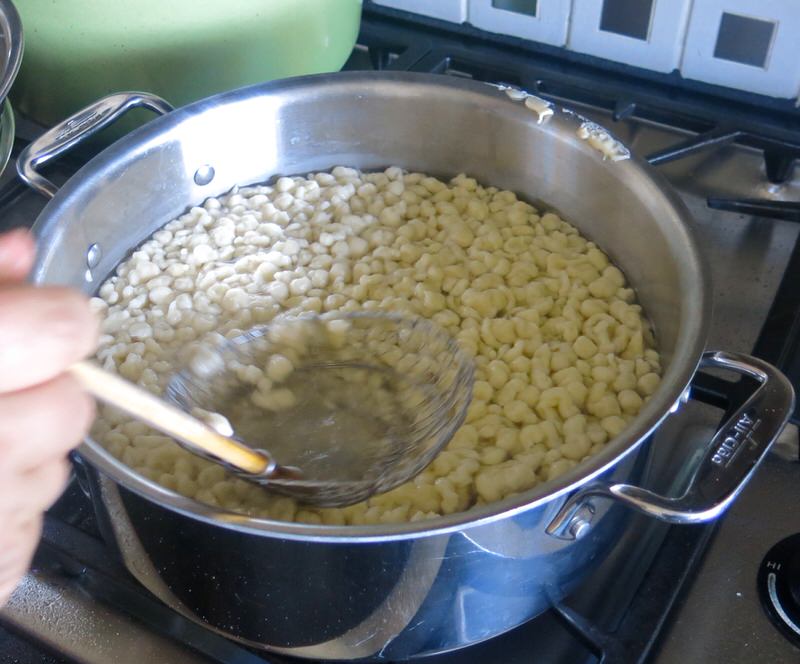
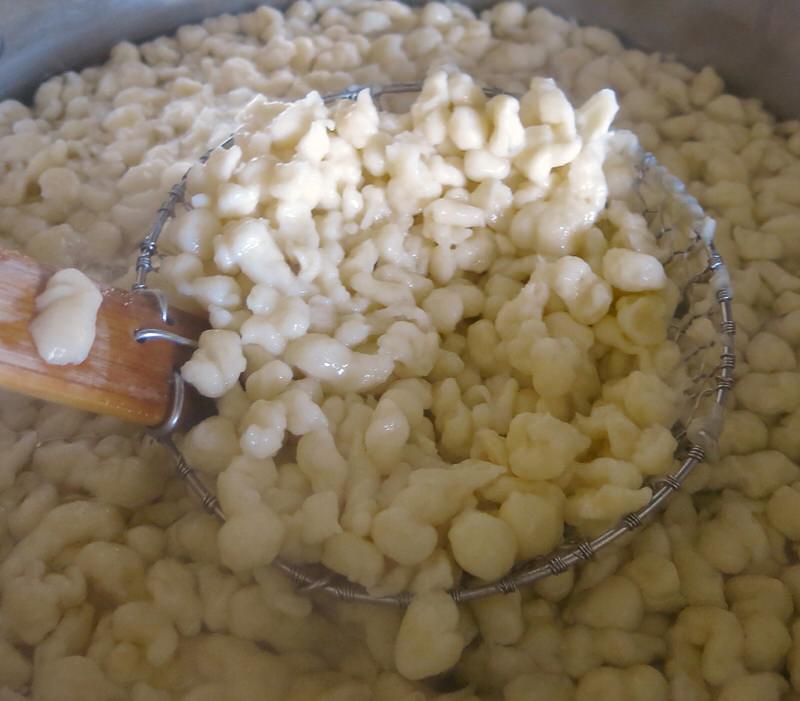
Repeat until all dough is coddled into plump little sparrows, all buttered and ready to serve! Before finishing, Margaret did demonstrate hand cutting.
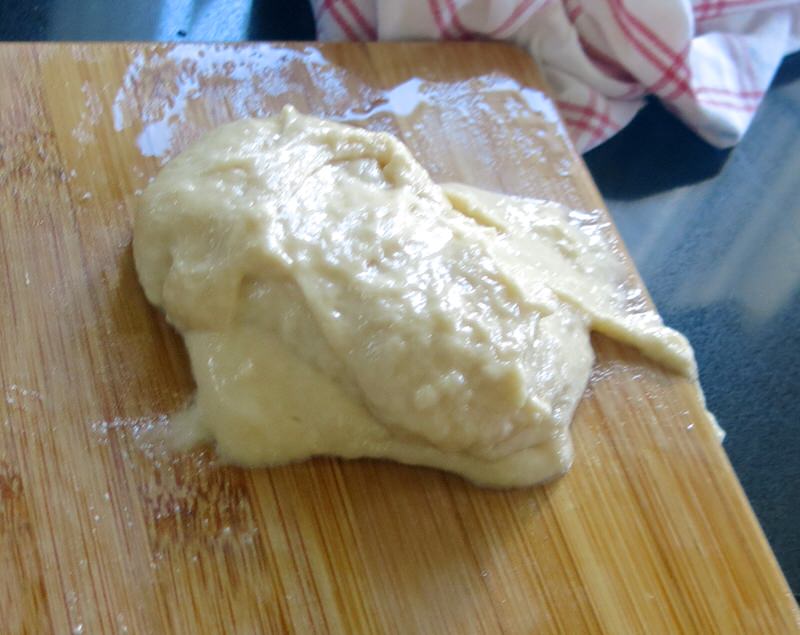
Again, the correct consistensy of the dough is evident, above, as the dough does not spread on the board like a batter would. It sits where plopped. The board must be wet. She said, “I don’t know why, but I know it must be. That is always how it was done at home. And, they made them so fast it was like a blurr!”
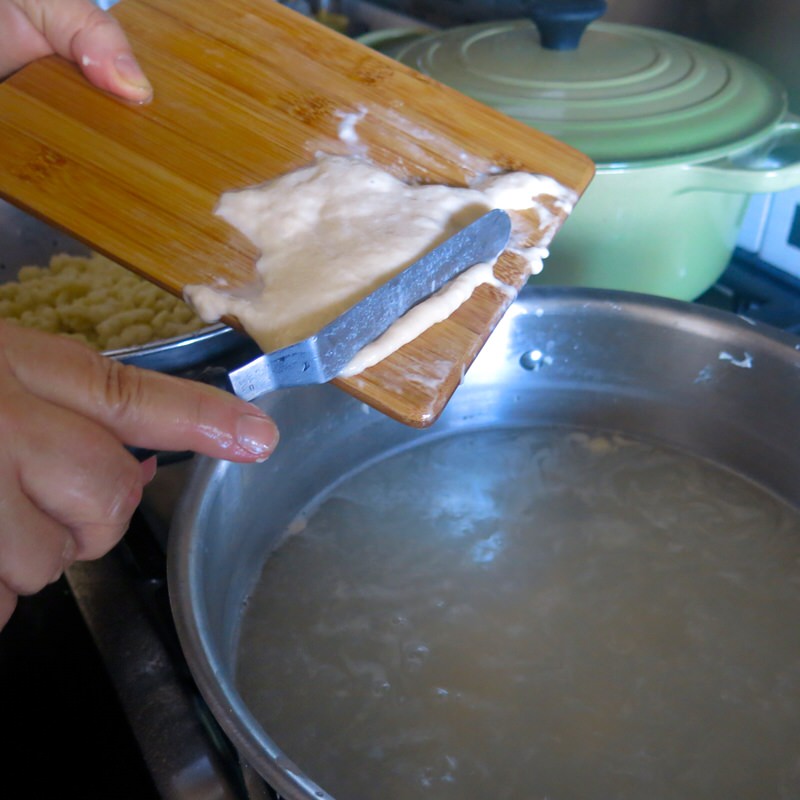
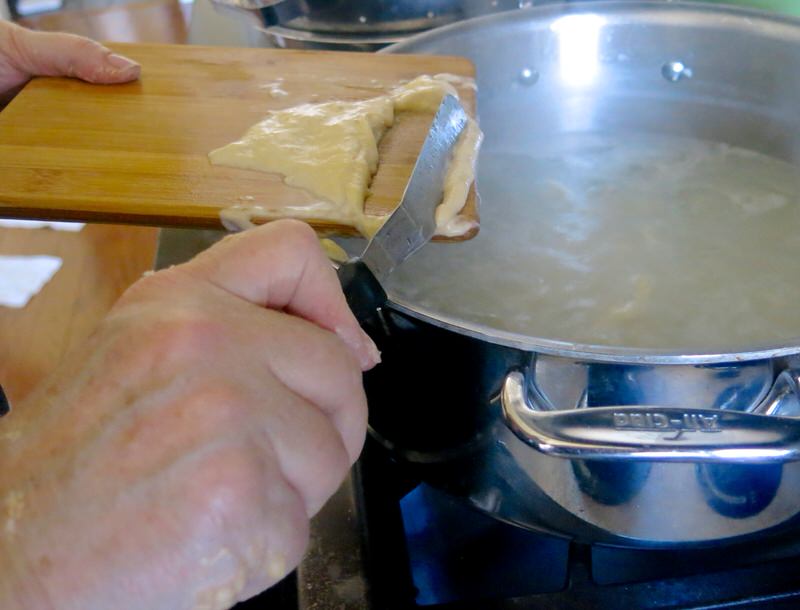
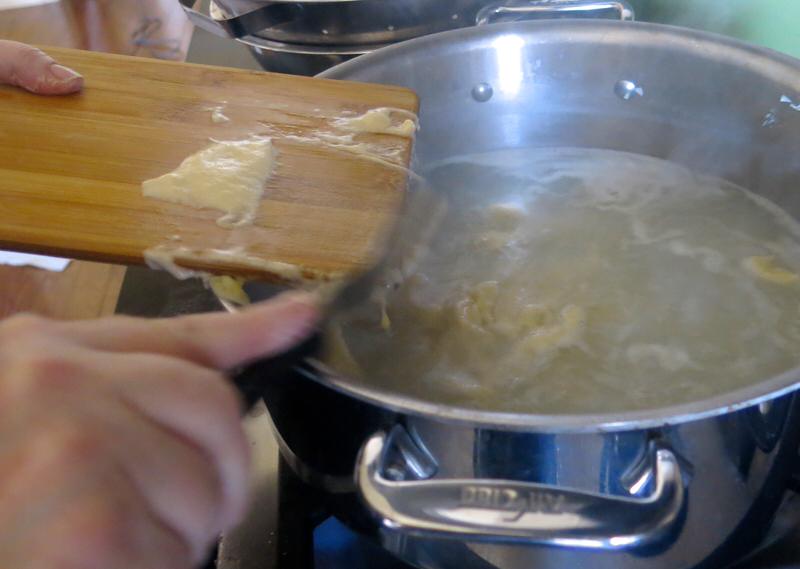
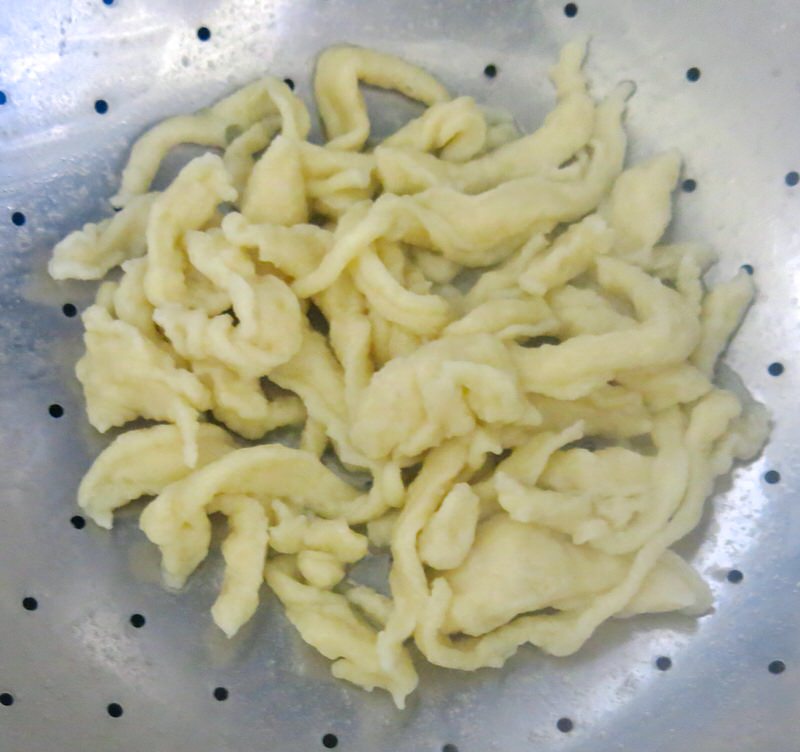
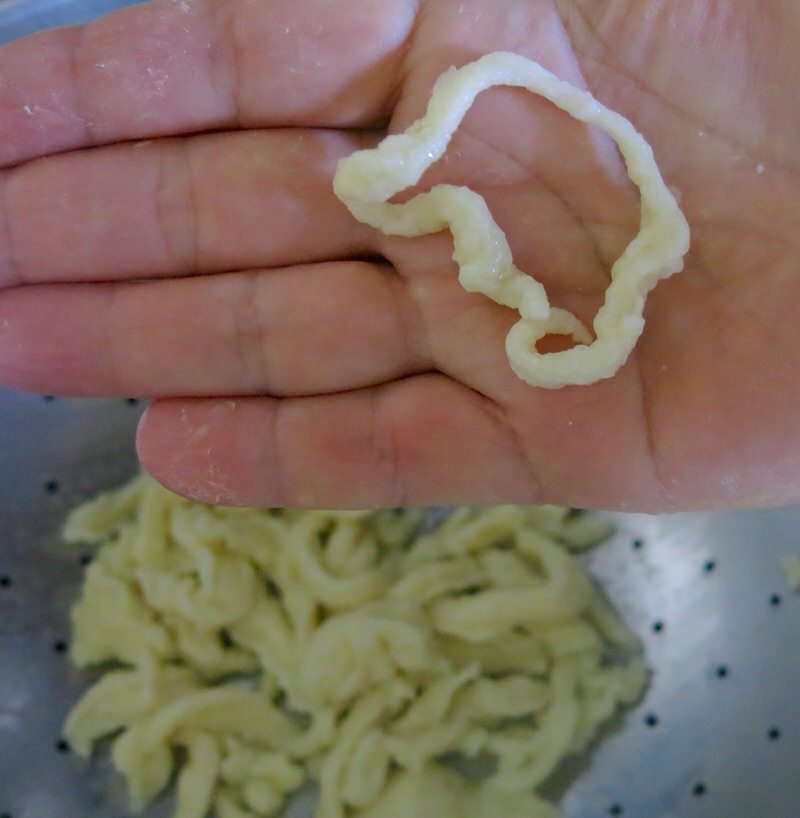
Of course, we did not. We got fat little tapers, nothing like the elegant shoots you will see in some images of hand cut Spaetzle. But, it was sure fun! Above, right, is the proper width.
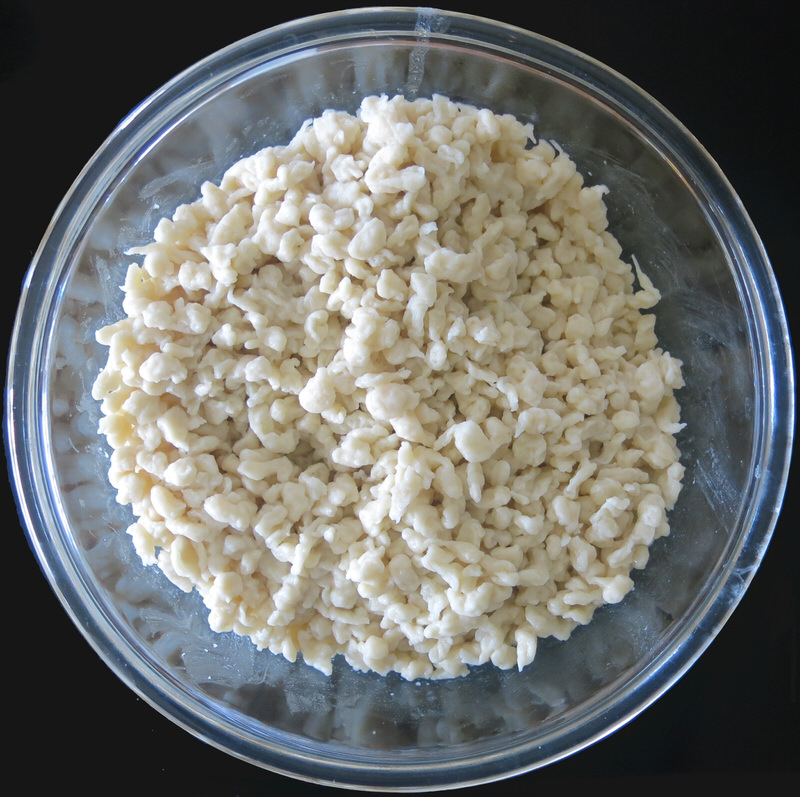
Look at our achievement. That is one mighty big bowl. But, I wouldn’t make less when I do it again. Why? They freeze beautifully and I really enjoy the flavour, the toothy mouth feel and the variety of ways they can be prepared.
German Spaetzle or Spätzle (soft egg noodle): Freezing the Noodles
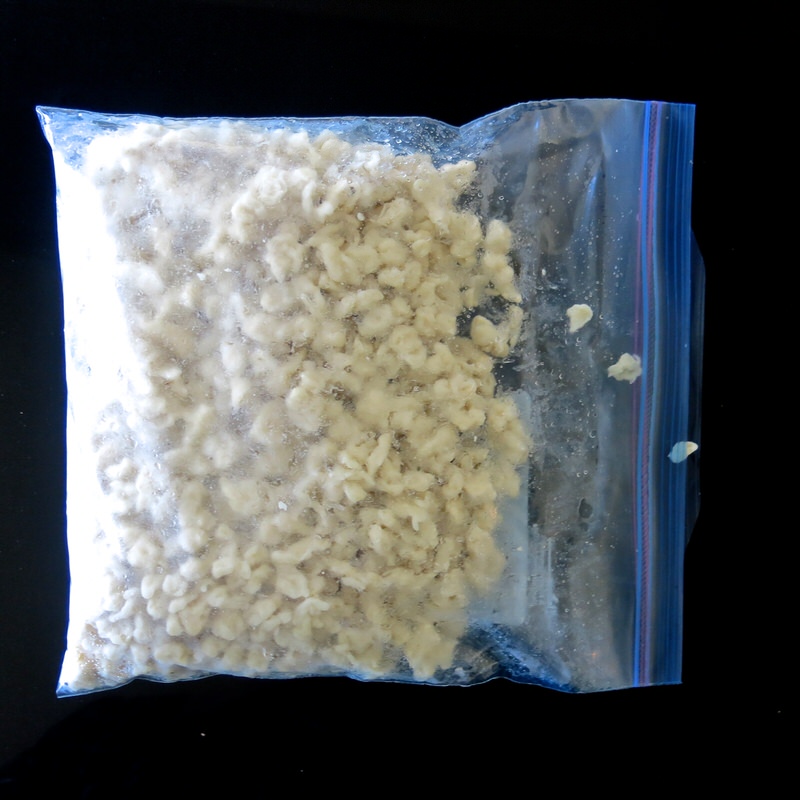
Lay them flat in a labeled and dated freezer bag and freeze until needed. Thaw and serve as you would freshly made.
German Spaetzle or Spätzle (soft egg noodle): Serving the Noodles
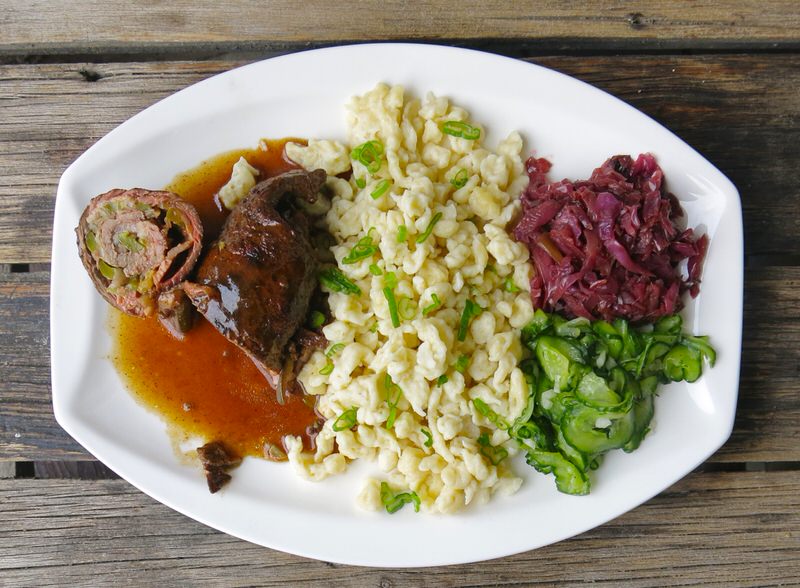
This recipe is an important side for the wonderful Bose Johnson traditional Christmas Eve dinner, above. We made all four recipes together, and all are posted here: The German Fleisch Rouladen, the Braised Purple Cabbage and the Cucumber Salad. What an exceptional treat. This was one memorable Sunday Supper!
German Spaetzle or Spätzle (soft egg noodle): Brown Butter and Onion Spaetzle Hash Browns!
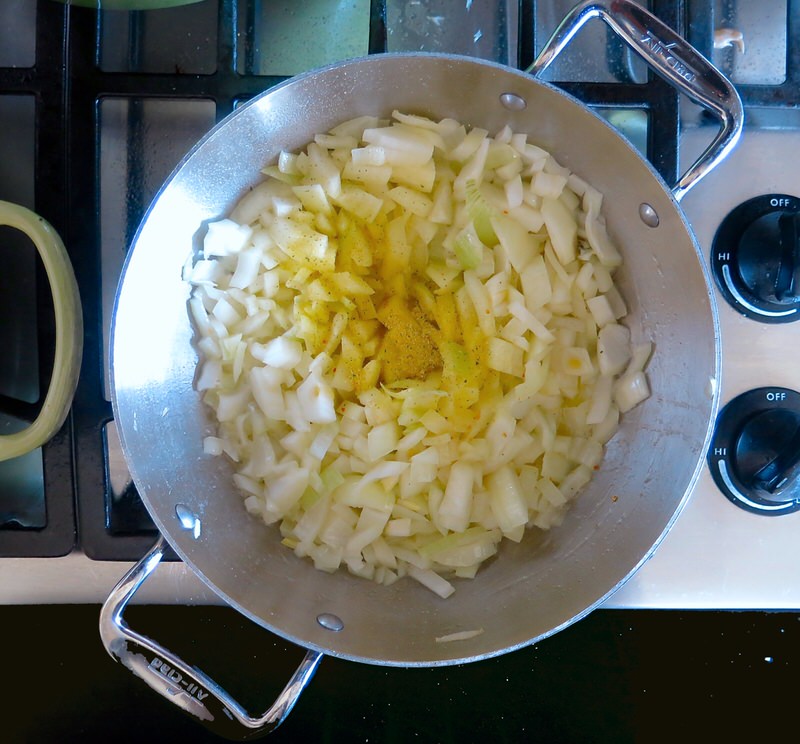
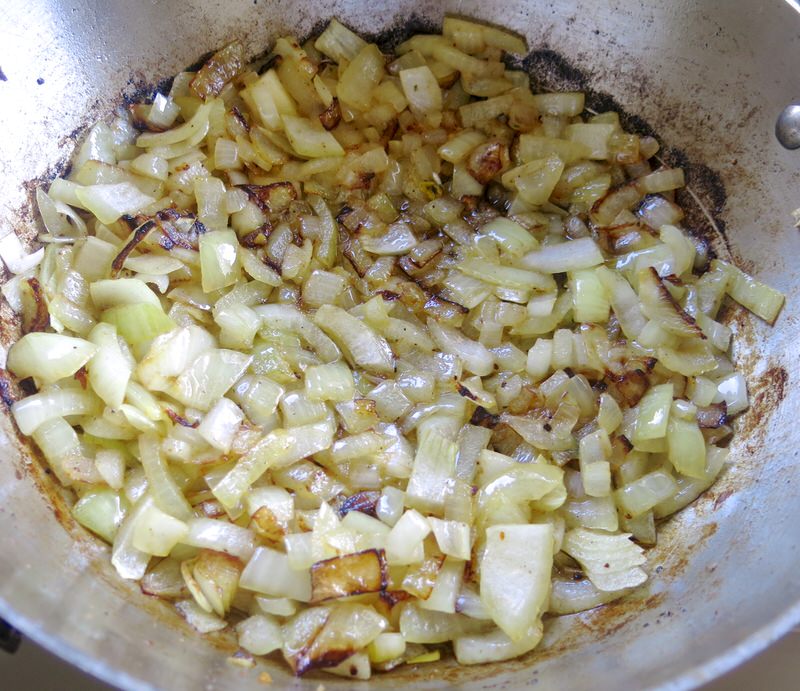
Brown butter and onions: sweat them and caramelize them.
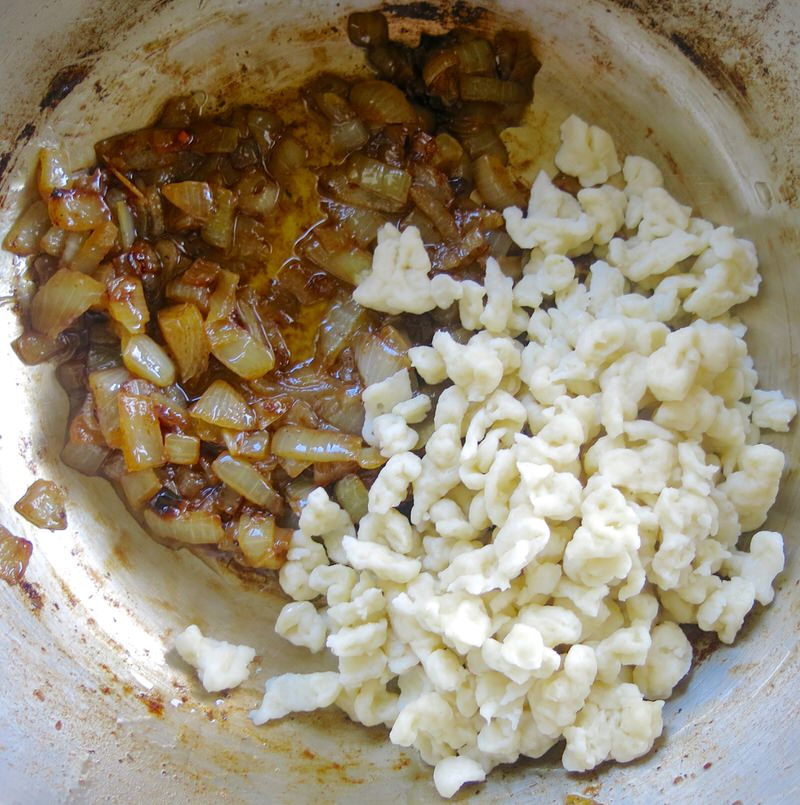
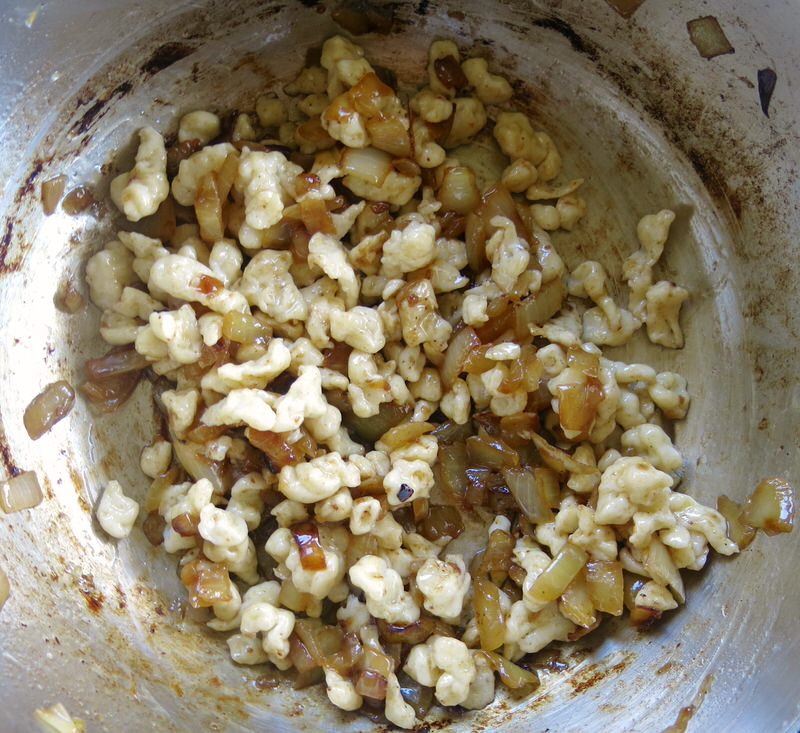
Add the Spaetzle. Toss.
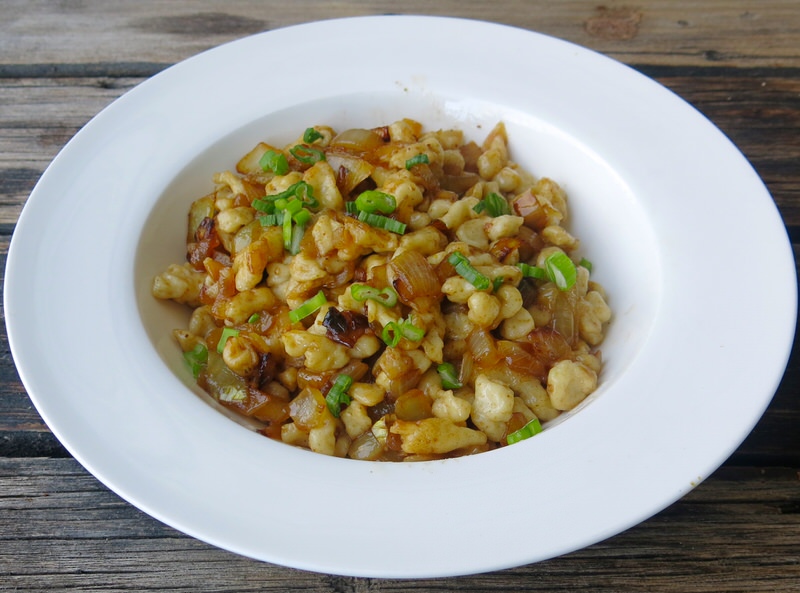
Serve with a garnish of crisply shaved tender green onions.
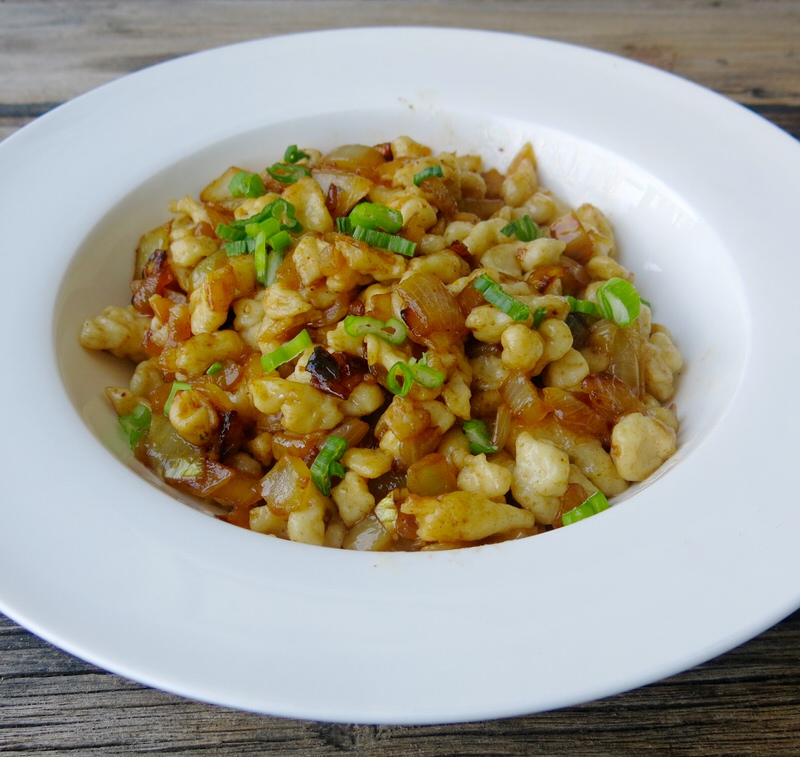
Yes! Vanja loved it. I heard the gutteral groan from the back of his throat after his first bite. Oh, Spaetzle and I have a future ahead. Yes, we do! Thank you, Miss Margaret! And, dear readers! Chime in! Do you make it? How? Favourite way? Favourite meal to serve it with? Inquiring minds want to know!
Recipes for the complete Bose Johnson Christmas Eve Fleish Rouladen Dinner:
- Rouladen
- Spaetzle
- Braised Purple Cabbage
- Cucumber Salad and
- Margaret’s Post about her experience here which includes information about how to prepare ahead for a crowd.
German Spaetzle or Spätzle
German Spaetzle or Spätzle in the Kitchen with Margaret Bose-Johnson. Step by step images. Specific Spätzle dough consistency information and instructions.
Ingredients
- 12 eggs
- 150 ml water
- 150 ml milk
- 1 tablespoon salt
- 6 cups flour
Materials Required
- Colander
- Spatzle Maker
- Hard non-pliable spatula
Instructions
Instructions for Making the dough:
- In large bowl, whisk eggs, milk, water and salt using an electric mixer; add flour in batches and beat until combined, thick and elastic and correct consistency is achieved (see note below)
- Dough will bubble as air pockets form within it; it will be very stretchy and elastic, and will stay in place when plopped on a working surface.
- Bring large pot of lightly salted water to boil over high heat; rest Spaetzle Maker over top of pot or boiling water, removing sliding box on top of maker
- Pour a portion of batter directly onto middle of device
- Using a hard, non-flexible spatula, push dough through holes of maker with spatula by forcefully sliding it back-and-forth over holes in surface of maker until dough is used and has dropped into boiling water below
- Quickly stir noodles in boiling water to avoid clumping together; once water just returns to a boil (about 1 to 2 minutes) and they rise to the surface, then remove noodles with slotted spoon and place in colander to drain
- Butter each batch of noodles in colander; toss to completely cover and to keep separate (avoid clumping)
- Once strained and the next batch is in boiling water, remove first batch from colander to big bowl
- Continue process until dough is finished: we used one “large plop of dough” on maker and pushed two “plops of dough” through per batch before removing from boiling water
Spaetzle Consistency
- You have the correct consistency when the dough holds its own. It is shiny and sheets when pulled. It is elastic and will stay and a blob when placed on a small board. The dough will not “run” or slide. It is more dough-like than batter-like when the correct consistency has been reached.
Instructions for Making the Dough in the Thermomix Machine:
- Weigh and place all ingredients into the TM bowl; mix to combine for 10 seconds speed 2-5 until dough starts to clump
- As dough must be shiny and elastic, beat dough 4 more times for 10 seconds each speed 5-8; check for consistency
- Add more flour, if necessary (depending upon humidity and elevation, etc), but this is a very full proof recipe with 2 eggs per cup of flour
- Dough will bubble as air pockets form within it; it will be very stretchy and elastic, and will stay in place when plopped on a working surface.
- Bring large pot of lightly salted water to boil over high heat; rest Spaetzle Maker over top of pot or boiling water, removing sliding box on top of maker
- Pour a portion of batter directly onto middle of device
- Using a hard, non-flexible spatula, push dough through holes of maker with spatula by forcefully sliding it back-and-forth over holes in surface of maker until dough is used and has dropped into boiling water below
- Quickly stir noodles in boiling water to avoid clumping together; once water just returns to a boil (about 1 to 2 minutes) and they rise to the surface, then remove noodles with slotted spoon and place in colander to drain
- Butter each batch of noodles in colander; toss to completely cover and to keep separate (avoid clumping)
- Once strained and the next batch is in boiling water, remove first batch from colander to big bowl
- Continue process until dough is finished: we used one “large plop of dough” on maker and pushed two “plops of dough” through per batch before removing from boiling water
Spaetzle Consistency:
- This is as much a dough as it is a batter. A batter is loose. A dough is tight. Yet, a batter is shiny and a dough is matte. This is a shiny dough. You have the correct consistency when the dough holds its own when plopped onto a work surface and oozes slowly like lava. It is elastic and will stay momentarily in a blob when placed on a small board or on the maker. The dough is viscous and will “run” or slump slowly. It is dough-like and batter-like when the correct consistency has been reached. It is shiny and “sheets” when pulled from the bowl with a spatula as in the above photo. You have to pinch it to separate the portions as it is so elastic and stretches so much. You will also see, below, during the making of the noodles, how the dough sits on the Spaetzle Maker. The dough can be made looser, and some do that, by adding more liquid. The noodle texture is then different, lighter and softer, some might say “fluffier” but this is often done due to personal preference, upbringing, or to accommodate the process due to the maker being used. Margaret’s mom only used eggs, flour and salt. They were raised with a chewy, toothsome eggy noodle. This is what she grew to love and has taught us here.
Freezing Spaetzle:
- Place in single layer in labeled dated freezer bag; freeze
- Thaw and use as you would fresh spaetzle
Notes
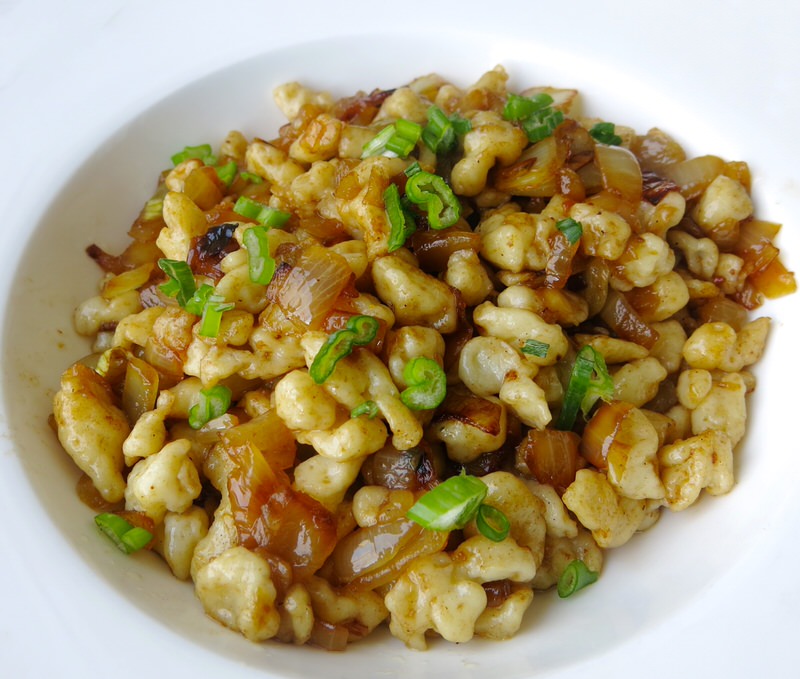
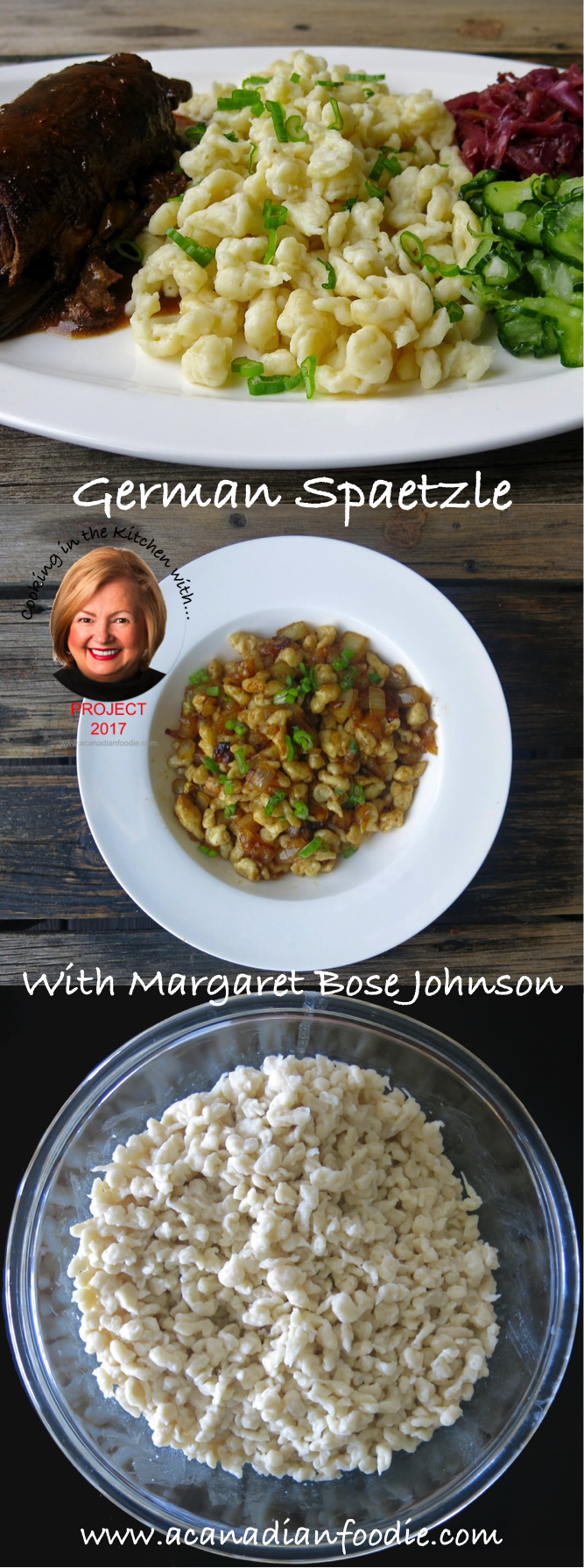
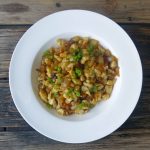
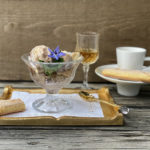
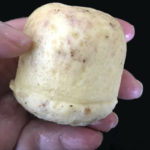
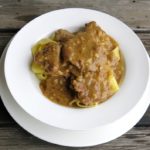
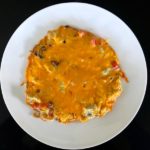
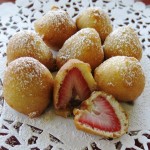
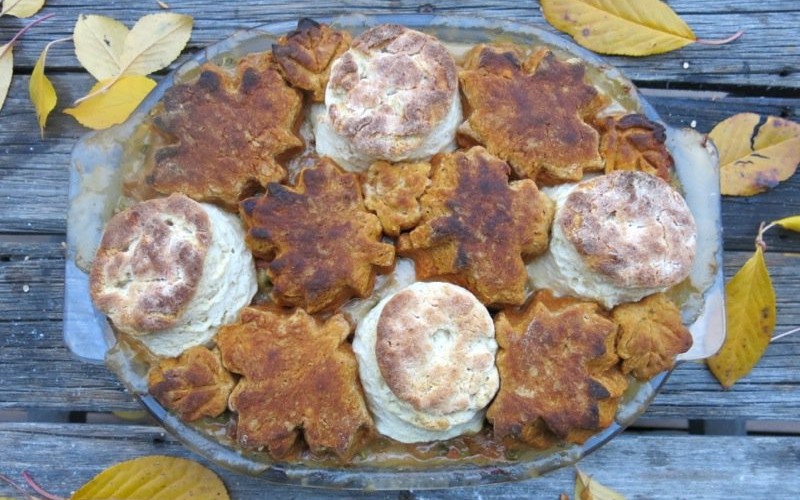





Valerie, I LOVE your writing, and your description of the ‘little sparrows’ plopping into the dough made me laugh! You have taught ME a thing or two about Spätzle – I have never heard of them being served as a sweet dish with apples or cherries (though now that I think of it, my mom often filled perogies with fruit fillings and we ate them as a meal – this would be a similar idea). I can’t wait to try the Spätzle now as a sweet dish – I know my family will love it. Your description of the dough/batter is right on and should be a great help for anyone attempting this versatile German noodle for the first time. It was a lot of fun making these with you.
With Vanja also coming from Eastern Europe, and all the traveling we have done there, Margaret, I wasn’t surprised, either, to discover they are served sweet in some specific regions of Germany. Both versions come from the same region and both sound delicious. Grating the apples into the dough fascinated me. There isn’t anything a loving mama in her kitchen can’t concoct when she’s trying to feed a hungry family with only a few simple ingredients. Learning how to make this without that little annoying box on top of the maker was transformative for me. I used to think like that all by myself. What has happened to me? Oh, don’t tell me. I know.
🙂
OX
Valerie
Danke für das Rezept!
Lacking fancy kitchen gadgets, I extruded the dough through a hole cut into the corner of a resealable plastic freezer bag (strong enough to withstand the back-pressure), as one might do with frosting. I wondered if it would turn out to be Spätzleghetti, but the dough actually broke up into shorter sparrow-like pieces. I also added Emmentaler & sautéed Zwiebeln to turn it into Käsespätzle, which meine Frau went wild for. Now I just need to try the Rouladen recipe…
~Cheers~
WOWOWOW! sounds delish! Thanks for sharing!
🙂
Valerie
Thank you for al your recipes. I am planning to make the whole Rouladen meal for Christmas Eve and I’d like to make most in advance. What is the best way to reheat the frozen spaetzle? Can the frozen spaetzle go straight in boiling water to reheat? Thank you for your help!
Hi Lori
Yes, it can!
I have also just zapped it in the mircrowave, depending upon the leftover amount. If it has been fried with butter etc, best to microwave it.
🙂
Valerie
Thank you so much for the quick reply. I look forward to trying all your recipes!